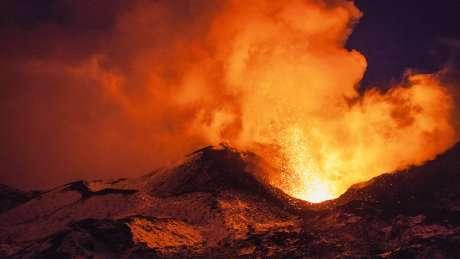Magma reservoirs key to volcanic eruptions

New study shows the importance of large reservoirs in creating Earth's most powerful volcanic eruptions and explains why they are so rare
Large reservoirs of magma stored deep in the Earth's crust are key to producing some of the Earth's most powerful volcanic eruptions, new research has shown.
In a new study, an international team of scientists claim that the most powerful volcanic eruptions, dubbed 'super-eruptions', are triggered by a slow and steady drip feed of magma from large reservoirs deep within the Earth's crust into smaller reservoirs closer to the surface.
These large reservoirs draw in hot magma from the Earth's mantle and exist as large volumes of partially molten rock that are able to store magma like a sponge.
By conducting a number of numerical simulations of this process, the research team showed that these large reservoirs are crucial to generating the largest volcanic eruptions on Earth.
The team also showed that these large reservoirs can take millions of years to form, hence why 'super-eruptions' happen so rarely.
It is believed that these findings could help to understanding why some volcanoes erupt frequently and at certain magnitudes.
The study has been published in the journal Nature Geoscience.
The amount of magma that is stored in the upper layer of the Earth's crust determines the frequency and magnitude of volcanic eruptions. Small eruptions that erupt less than one cubic kilometre of material occur very frequently (daily to yearly), whilst the largest eruptions that erupt hundreds of cubic kilometres of material are infrequent, with hundreds of thousands of years between them.
Co-author of the study Dr Wim Degruyter, from Cardiff University's School of Earth and Ocean Sciences, said: "Our current understanding tells us that hot magma can be injected from the Earth's lower crust into colder surroundings near the surface. At this point, the magma can either erupt or cool down to such a point that the magma solidifies and an eruption does not occur."
"Up until now, this theory hasn't been able to explain how the magma can maintain its heat in these near-surface reservoirs and thus produce extremely powerful eruptions."
Previous research has revealed that a deeper magma body connects to a magma reservoir in the upper part of the crust underneath Yellowstone – one of the world's largest supervolcanoes. The deeper magma body sits 12 to 28 miles below the surface and it's believed that the hot molten rock could fill the 1,000-cubic-mile Grand Canyon 11.2 times. The last known eruptions from Yellowstone were 2m, 1.2m and 640,000 years ago, and it is believed that these were fed by the volcanic plumbing system that sits beneath it.
"Our calculations appear to agree with the observations that have been made at Yellowstone," Dr Degruyter continued.
More information: Ozge Karakas et al. Lifetime and size of shallow magma bodies controlled by crustal-scale magmatism, Nature Geoscience (2017). DOI: 10.1038/ngeo2959
Journal information: Nature Geoscience
Provided by Cardiff University



















